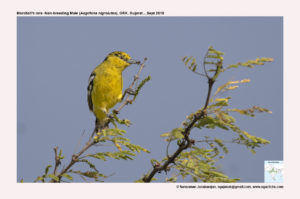Marshall’s-Iora-non-breeding-male

Marshal’s Iora Aegithina nigrolutea
Etymology:
- Aegithina : Greek word for aigithos or aiginthos unknown and mythical bird
- Nigrolutea : Latin word niger – black; luteus- saffron-yellow.
Vernacular Names: Hindi: Shaubeega, Desi/ Samanya Shaubeegi, Sans: Bharat shukkika, Pun: Latu, Ben: Fatik-jal, Ass: Krishna sorai, Barsat-sorai, Cachar: Daotisha gurrmo, Mikhir: Vohjong pong, Naga: Inga-ruina, Guj: Shobinga, Madhya bharati shobinga, Pilo shobigi, Mar: Cheroka, Subhag/Shubhalg(?), Ta: Pachapora, Chinna mambala-kuruvi, Mambala chittu, Te: Patsu-jitta, Pacha jitta, Pattra-jitta, Mal: Dadi-dee, Kan: Madhura kantha, Sinh: Kirikaye, Ca-kurulla, Panu-kurulla
Distribution in India: Breeds in Ladhak, winter visitor in North West India.
Description: Size of 12–12·8 cm; weight of male 11–14 g, weight of female 10–14 g. The male in breeding plumage has face, underparts and broad collar as rich yellow, collar with small amount of black fringing; cap and upper body except rump solidly black, rump is chalky green; tail is black with bold white tipping, lateral feathers white along web margins. The wings are black, median upperwing-coverts and tips of greater coverts are white forming two conspicuous bars, tertials and inner secondaries broadly edged white, tertials also broadly tipped white .The iris is brown; bill is light grey-blue with blackish culmen ridge; feet is slaty grey. Some individuals recorded from Sri Lanka are greener-backed and show reduced black on head in breeding plumage. The male in post-breeding eclipse plumage resembles female, but wings and tail are black, some black smudging on nape. The female is entirely chalky-washed green above; tail centre is silvery grey, black on wings restricted. The underparts are paler, more greenish-yellow, than male. The juvenile resembles female; adult tail colours assumed at post-juvenile moult.
Habitat: It is found exclusively at plains level in thorny acacia jungle, and scrubby groves and gulleys and park-like woodland at up to 700 m.
Food habits: It eats arthropods, including insect and larvae. It hunts alone or in pairs, but joins mixed foraging parties after breeding season. It forages among outer twigs and crown foliage, often acrobatically to assist leaf-scanning.
Breeding habits: They breed in June and July in India. The nest is built by both pair-members. The nest is a small, very neat cup made of fibre and grass, lined sparsely with hair, felted externally with cobweb, placed in fork of Salvadora bush or directly on to bark surface of mimosa or fig. They lay a clutch of 2–3 eggs. The incubation is done by both sexes, and both also tend young, including either swallowing faecal sacs or dropping them at a distance from nest.